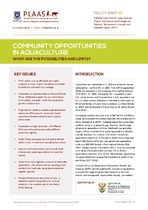| dc.contributor.author | Hara, Mafaniso | |
| dc.contributor.author | Njokweni, Gugu | |
| dc.contributor.author | Njokweni, Belemane | |
| dc.date.accessioned | 2016-10-20T13:25:26Z | |
| dc.date.available | 2016-10-20T13:25:26Z | |
| dc.date.issued | 2016 | |
| dc.identifier.citation | Hara, M. et al. (2016). Community opportunities in aquaculture: what are the possibilities and limits? Policy Brief 46, Bellville: Institute for Poverty, Land and Agrarian Studies, University of the Western Cape | en_US |
| dc.identifier.uri | http://hdl.handle.net/10566/2457 | |
| dc.identifier.uri | http://www.plaas.org.za/plaas-publication/pb46-aquaculture-mh | |
| dc.description.abstract | Aquaculture now contributes 47% of fish available for human
consumption – up from 9% in 1980. This shift to aquaculture
offsets the stagnation in the production from capture fisheries
(FAO 2012). By 2030, demand for fish is expected to reach
261 million tonnes, but fish production is only expected to rise
to 210 million tonnes; demand will therefore exceed supply by
50 million tonnes. Africa is likely to produce 11 million tonnes
by 2030, but the demand will be as high as 18 million tonnes
(FAO 2013). | en_US |
| dc.description.sponsorship | Department of Agriculture, Forestry and Fisheries | en_US |
| dc.language.iso | en | en_US |
| dc.publisher | Institute for Poverty, Land and Agrarian Studies, University of the Western Cape | en_US |
| dc.relation.ispartofseries | Policy Brief;46 | |
| dc.rights | Copyright © 2016 | PLAAS - Institute for Poverty, Land and Agrarian Studies. | |
| dc.subject | Aquaculture | en_US |
| dc.subject | Community enterprises | en_US |
| dc.subject | Markets | en_US |
| dc.subject | Value chain | en_US |
| dc.subject | Food security | en_US |
| dc.subject | Intellectual property rights | en_US |
| dc.title | Community opportunities in aquaculture: what are the possibilities and limits? | en_US |
| dc.type | Other | en_US |
| dc.privacy.showsubmitter | false | |
| dc.status.ispeerreviewed | false | |

